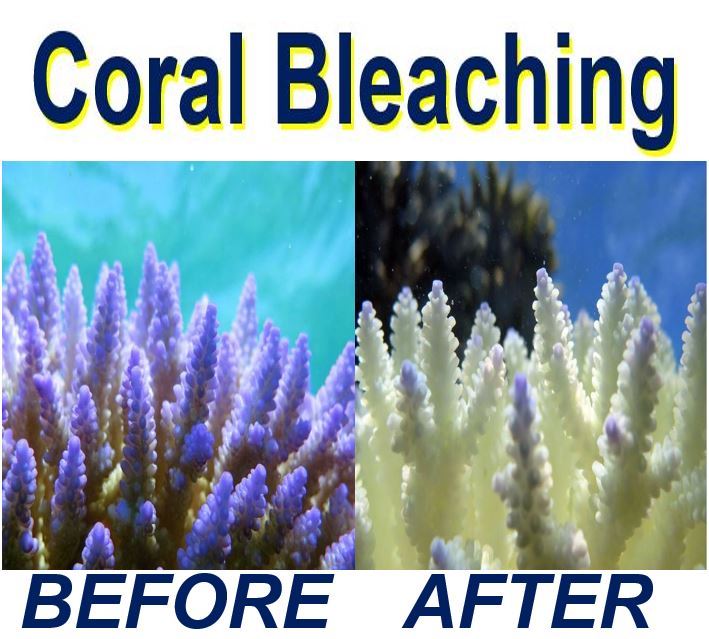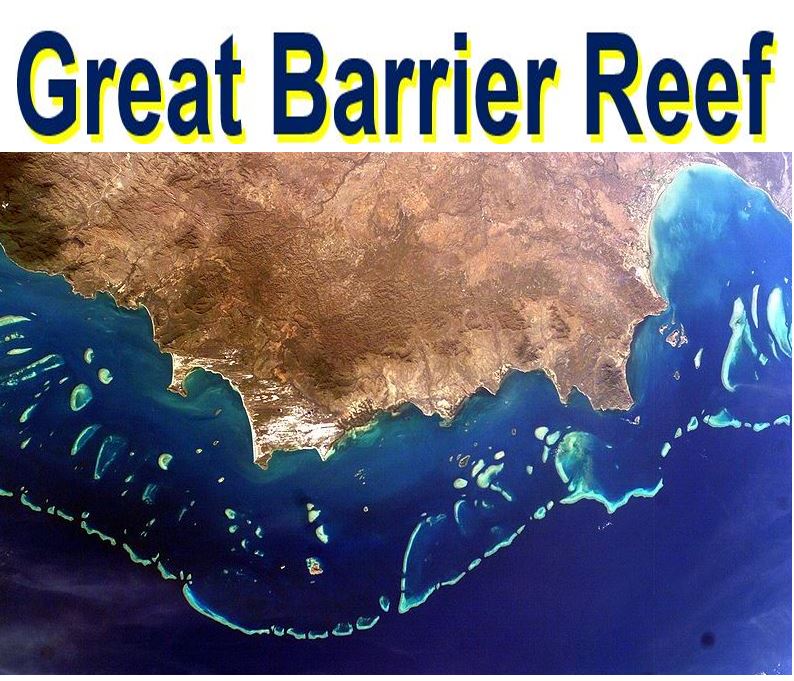Scientists said the extent of coral bleaching in the Great Barrier Reef is both astonishing and shocking – ninety-three percent of the world’s largest coral reef system has experienced damage, a group of scientists announced on Wednesday.
The final results of comprehensive underwater and aerial surveys show damage that changes dramatically from north to south along the length of the 2,300 km (1,400 mile) of the Reef – damage is considerably worse in the northern sector.
Meanwhile, on Australia’s west coast, scientists are also discovering extensive bleaching caused by rising temperatures on both sides of the Australian mainland.
 Mass Coral bleaching occurs when hotter sea temperatures due to global warming cause corals to expel minuscule photosynthetic algae, known ‘zooxanthellae’. When these colourful algae are lost, the corals turn translucent (semi-transparent) and white, and ‘bleach’. (Image: James Cook University)
Mass Coral bleaching occurs when hotter sea temperatures due to global warming cause corals to expel minuscule photosynthetic algae, known ‘zooxanthellae’. When these colourful algae are lost, the corals turn translucent (semi-transparent) and white, and ‘bleach’. (Image: James Cook University)
Scale of coral bleaching unprecedented
Professor Terry Hughes, convenor of the National Coral Bleaching Taskforce, which is documenting and studying the event, said regarding the scale of the bleaching:
“We’ve never seen anything like this scale of bleaching before. In the northern Great Barrier Reef, it’s like 10 cyclones have come ashore all at once. Towards the southern end, most of the reefs have minor to moderate bleaching and should soon recover.”
“We have now flown over 911 individual reefs in a helicopter and light plane, to map out the extent and severity of bleaching along the full 2,300km length of the Great Barrier Reef. Of all the reefs we surveyed, only 7% (68 reefs) have escaped bleaching entirely.”
“At the other end of the spectrum, between 60 and 100% of corals are severely bleached on 316 reefs, nearly all in the northern half of the Reef.”
The accuracy of the aerial surveys has been confirmed by teams of scientific divers, who continue measuring the ongoing impact of the bleaching.
 The Great Barrier Reef can be seen from outer space – and is the world’s largest single structure made by living organisms. The reef structure is composed of and built by trillions of ultra-tiny organisms, known as coral polyps. (Image: umn.edu/earthducation)
The Great Barrier Reef can be seen from outer space – and is the world’s largest single structure made by living organisms. The reef structure is composed of and built by trillions of ultra-tiny organisms, known as coral polyps. (Image: umn.edu/earthducation)
Extreme bleaching in Northern Sector of Reef
Prof. Andrew Baird from the ARC Centre of Excellence for Coral Reef Studies, who has been at sea for the last seventeen days, said:
“The bleaching is extreme in the 1000km region north of Port Douglas all the way up to the northern Torres Strait between Australia and Papua New Guinea. Tragically, this is the most remote part of the Reef, and its remoteness has protected it from most human pressures: but not climate change.”
“North of Port Douglas, we’re already measuring an average of close to 50% mortality of bleached corals. At some reefs, the final death toll is likely to exceed 90%. When bleaching is this severe it affects almost all coral species, including old, slow-growing corals that once lost will take decades or longer to return.”
Central and southern bleaching less severe
Across a 600 km (373 m) central band of the Great Barrier Reef, between Mackay and Cairns, more modest bleaching is currently reaching its peak. Scientists report that reefs further south appear to have been spared damaging levels of bleaching, mainly because sea temperatures there were closer to the normal summer conditions over recent months.
Regarding the bleaching in the central section of the Great Barrier Reef, Prof. Hughes said:
“The severity of bleaching in the central section is less, and closer to the intensity of the first two mass bleaching events on the Barrier Reef, in 1998 and 2002.”
“Thankfully, many of the corals there are more moderately bleached, so we expect that most of them will survive and regain their normal colour as temperatures drop over the coming months.”
 According to the Coral Centre of Excellence, the most severe and intense bleaching has occurred in the Northern Sector of the Great Barrier Reef. Percentages of severe bleaching range from 81% in the North to 1% in the South. (Image: James Cook University)
According to the Coral Centre of Excellence, the most severe and intense bleaching has occurred in the Northern Sector of the Great Barrier Reef. Percentages of severe bleaching range from 81% in the North to 1% in the South. (Image: James Cook University)
In this latest survey, after gathering and analyzing all the data, the researchers found that the huge footprints of the three mass bleaching events in 1998, 2002 and 2016 are different. In each case, the most severe bleaching has coincided with where the warmest water sits for the longest period, Prof. Hughes explained.
Prof. Hughes added:
“This time, the southern third of the Great Barrier Reef was fortunately cooled down late in summer by a period of cloudy weather caused by ex-cyclone Winston, after it passed over Fiji and came to us as a rain depression. The 2016 footprint could have been much worse.”
Economic importance of the Reef
According to the Australian Government, Reef Tourism generates an annual income of approximately AUD$5 billion and directly provides about seventy thousand jobs. The Government says it has long-recognised that global warming (climate change) is the largest threat to the Great Barrier Reef and the people whose livelihoods depend on it.
 Coral reefs serve as habitats for thousands of species of marine life. Australian scientists say they have not detected any reduction in fish or other marine life populations around the severely bleached areas of the Great Barrier Reef. However, they are concerned. (Image: Wikipedia)
Coral reefs serve as habitats for thousands of species of marine life. Australian scientists say they have not detected any reduction in fish or other marine life populations around the severely bleached areas of the Great Barrier Reef. However, they are concerned. (Image: Wikipedia)
Daniel Gschwind, Chief Executive of the Queensland Tourism Industry Council, said:
“Thankfully, many parts of the reef are still in excellent shape, but we can’t just ignore coral bleaching and hope for a swift recovery. Short-term development policies have to be weighed up against long-term environmental damage, including impacts on the reef from climate change.”
On Australia’s west coast, scientists from the national task-force are currently also documenting extensive bleaching along the coastline and on offshore atolls.
Dr. Verena Schoepf from the University of Western Australia, said:
“The coastal area that I study north of Broome has huge tides, and we thought the corals there are tough ‘super corals’ because they can normally cope with big swings in temperature. So, we’re shocked to see up to 80% of them now turning snow-white. Even the tougher species are badly affected.”
 Most reef-building corals have a symbiotic relationship with zooxanthellae (above), a microscopic unicellular algae that lives within the cells of the coral’s gastrodermis. Coral bleaching occurs when the coral expels zooxanthellae. (Image:coralreef.noaa.gov)
Most reef-building corals have a symbiotic relationship with zooxanthellae (above), a microscopic unicellular algae that lives within the cells of the coral’s gastrodermis. Coral bleaching occurs when the coral expels zooxanthellae. (Image:coralreef.noaa.gov)
About coral bleaching
Coral bleaching on a large scale (Mass Coral Bleaching) happens when rising sea temperatures due to global warming cause corals to expel zooxanthellae, tiny photosynthetic algae that live in their tissues.
The loss of the zooxanthellae, which are very colourful, causes the corals to become translucent and white, and ‘bleach’.
Moderately-bleached corals can make a full recovery if sea temperatures return to normal and zooxanthellae can recolonize them – otherwise the coral may perish.
Video – Great Barrier Reef bleaching
An increase in sea temperatures – due to climate change and the El Niño weather pattern – has caused the worst coral bleaching in the history of the Great Barrier Reef. The Financial Times’ Jamie Smyth and marine scientist John Veron visit Orpheus Island to survey the damage.
